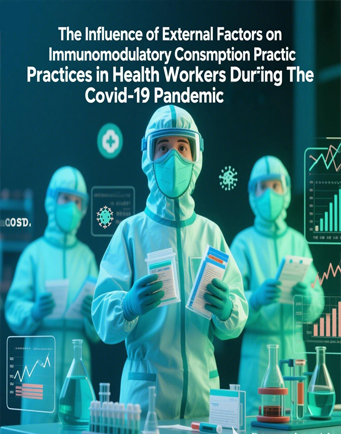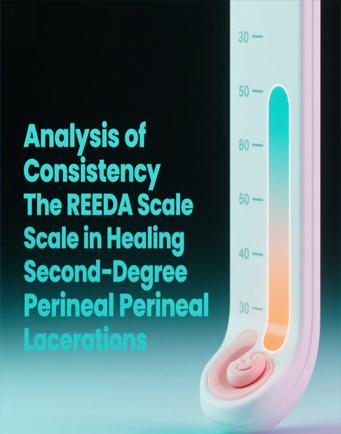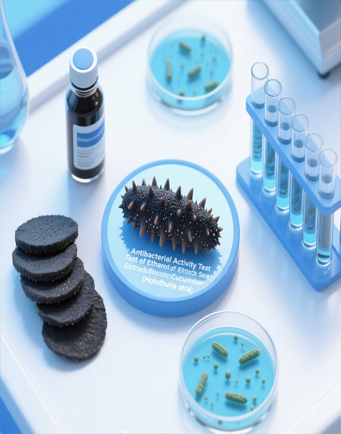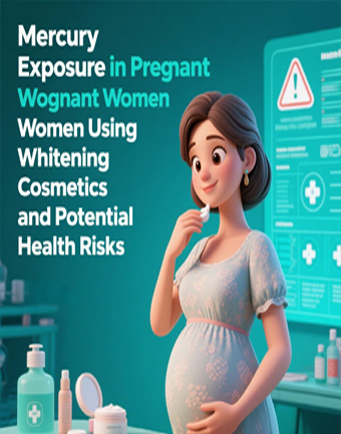Comparison of Total Bacterial Count in Contact Lenses with Different Treatments of Contact Lens Solutions

Downloads
The use of contact lenses continues to increase, raising attention to aspects of eye health because of their hygienic factors. The hygiene of contact lenses comes not only from the way they are treated but also from the soaking fluid. This study aimed to determine the total bacterial count on contact lenses with and without the use of immersion solutions. The research method used is a comparative descriptive research method that compares the two pairs of contact lenses with two different contact lens solutions. The total bacterial count was calculated using the total plate count (TPC) method. The number of bacterial colonies for contact lenses before being immersed in liquid A was found in dilution 10-2 with an amount of 4.4×103 CFU/mL, and after soaking, it was in dilution 10-1 with an amount of 8.5×102 CFU/mL. The number of bacterial colonies on contact lenses before being immersed in B liquid was found in 10-1 dilution with an amount of 1.3×103 CFU/mL, and after being soaked, the average colony was 3.9×104 CFU/mL. From these results, it can be seen that in contact lenses and liquid A, there is a decrease in the number of bacterial colonies, while on the other hand, in liquid B, there is an increase in the number of bacterial colonies. The causal factor is thought to originate from the composition of the solutions. However, do not rule out contamination from bottles and contact lens care. Therefore, this research can be used as a basis for hygiene education in contact lenses.
Barr, J. T., Lapple, W. J., Snyder, C. A., Hsu, J. C., & Tuovinen, O. H. (1988). Evaluation of Contact Lenses by Microbial Enumeration and Protein Determination. Optometry and Vision Science, 65(6), 476–480. https://doi.org/10.1097/00006324-198806000-00007
Centers for Disease Control and Prevention. (2022). Benefits of Vision Correction with Contact Lenses. CDC. Retrieved from: https://archive.cdc.gov/www_cdc_gov/contactlenses/benefits.html
Clark, B. J., Harkins, L. S., Munro, F. A., & Devonshire, P. (1994). Microbial contamination of cases used for storing contact lenses. Journal of Infection, 28(3), 293–304. https://doi.org/10.1016/S0163-4453(94)91893-7
Donzis, P. B., Mondino, B. J., Weissman, B. A., & Bruckner, D. A. (1987). Microbial Contamination of Contact Lens Care Systems. American Journal of Ophthalmology, 104(4), 325–333. https://doi.org/10.1016/0002-9394(87)90219-4
Durban, J. J., Villaverde, E. H., Monteoliva-Sanchez, M., & Ramos-Cormenzana, A. (1996). Bacterial Contamination of Hydrophilic Contact Lens Solutions Marketed in Spain. Optometry and Vision Science, 73(8), 529–532. https://doi.org/10.1097/00006324-199608000-00002
Eryılmaz, M., Kaskatepe, B., Kıymacı, M. E., Sımsek, D., & Erol, H. B. (2018). Antimicrobial efficacies of four multi-purpose contact lens care solutions. Journal of Faculty of Pharmacy of Ankara University, 42(2), 15-22. Retrieved from: https://dergipark.org.tr/en/pub/jfpanu/issue/42664/514443
Hadeel T AL-Hadithi, & Zahira M AL-Khani. (2023). Efficacy of two contact lens disinfecting solutions in reducing growth rate of bacteria and eradication of biofilms. World Journal of Biological and Pharmaceutical Research, 4(1), 016–023. https://doi.org/10.53346/wjbpr.2023.4.1.0048
Ibrahim, R. A., Husna, H. N., & Witjaksono, A. (2021). Hubungan Pengetahuan Pengguna Lensa Kontak dengan Kejadian Dry Eyes. Jurnal Kesehatan Holistic, 5(2), 40-51. https://doi.org/10.33377/jkh.v5i2.101
Iguban, E. B., & Nanagas, J. P. R. (2016). The In Vitro Anti-Microbial Activity of Multipurpose Contact Lens Solutions against Standard Strains of Common Ocular Pathogens: The Effect of Duration from First Use. Journal of Clinical & Experimental Ophthalmology, 7(3), 1-6. https://doi.org/10.4172/2155-9570.1000560
Indrayati, S., & Amelia, A. (2020). Uji Daya Hambat Cairan Pembersih Lensa Kontak Dalam Menghambat Pertumbuhan Staphylococcus aureus. Prosiding Seminar Kesehatan Perintis, 2(1), 18-24. Retrieved from: https://jurnal.upertis.ac.id/index.php/PSKP/article/view/327
Jamilatun, M., & Lukito, P. I. (2024). Total plate count and yeast mold count in liquid traditional medicine (Jamu) sold in the sukoharjo region market. International Journal of Basic and Applied Science, 12(4), 174–182. https://doi.org/10.35335/ijobas.v12i4.282
Laili, N. H., Abida, I. W., & Junaedi, A. S. (2022). Nilai Total Plate Count (TPC) Dan Jumlah Jenis Bakteri Air Limbah Cucian Garam (Bittern) Dari Tambak Garam Desa Banyuajuh Kecamatan Kamal Kabupaten Bangkalan. Juvenil:Jurnal Ilmiah Kelautan Dan Perikanan, 3(1), 26–31. https://doi.org/10.21107/juvenil.v3i1.15075
McAnally, C., Walters, R., Campolo, A., Harris, V., King, J., Thomas, M., Gabriel, M. M., Shannon, P., & Crary, M. (2021). Antimicrobial Efficacy of Contact Lens Solutions Assessed by ISO Standards. Microorganisms, 9(10), 2173. https://doi.org/10.3390/microorganisms9102173
Raksha, L., Gangashettappa, N., Shantala, G., Nandan, B., & Sinha, D. (2020). Study of biofilm formation in bacterial isolates from contact lens wearers. Indian Journal of Ophthalmology, 68(1), 23. https://doi.org/10.4103/ijo.IJO_947_19
ResearchAndMarkets.com. (2023). The Worldwide Therapeutic Contact Lenses Industry is Expected to Reach $4.2 Billion by 2027: Public and Private Initiatives to Increase Vision Care Awareness Drives Growth. Business Wire.
Rizki, Z., Fitriana, F., & Jumadewi, A. (2022). Identifikasi jumlah angka kuman pada dispenser metode TPC (Total Plate Count). Jurnal SAGO Gizi Dan Kesehatan, 4(1), 38-43. https://doi.org/10.30867/gikes.v4i1.1052
Statista Market Insight. (2022). Contact Lenses - Indonesia. Statista. Retrieved from: https://www.statista.com/outlook/cmo/eyewear/contact-lenses/indonesia#revenue
Szczotka-Flynn, L. B., Pearlman, E., & Ghannoum, M. (2010). Microbial Contamination of Contact Lenses, Lens Care Solutions, and Their Accessories: A Literature Review. Eye & Contact Lens: Science & Clinical Practice, 36(2), 116–129. https://doi.org/10.1097/ICL.0b013e3181d20cae
Tapotubun, A. M., Rieuwpassa, F., Matrutty, T. E., Nanlohy, H., & Apituley, Y. M. (2024). Total Plate Count of Traditionally Produced Smoked Skipjack in Ambon. IOP Conference Series: Earth and Environmental Science, 1329(1), 012012. https://doi.org/10.1088/1755-1315/1329/1/012012
Waghmare, S. V, & Jeria, S. (2022). A Review of Contact Lens-Related Risk Factors and Complications. Cureus,14(10): e30118. https://doi.org/10.7759/cureus.30118
Weisbarth, R. E., Gabriel, M. M., George, M., Rappon, J., Miller, M., Chalmers, R., & Winterton, L. (2007). Creating Antimicrobial Surfaces and Materials for Contact Lenses and Lens Cases. Eye & Contact Lens: Science & Clinical Practice, 33(6), 426–429. https://doi.org/10.1097/ICL.0b013e318157f488
Willcox, M. D., Harmis, N. Y., & Holden, B. A. (2002). Bacterial populations on high‐Dk silicone hydrogel contact lenses: effect of length of wear in asymptomatic patients. Clinical and Experimental Optometry, 85(3), 172–175. https://doi.org/10.1111/j.1444-0938.2002.tb03031.x
Copyright (c) 2024 JURNAL INFO KESEHATAN

This work is licensed under a Creative Commons Attribution-NonCommercial-ShareAlike 4.0 International License.
Copyright notice
Ownership of copyright
The copyright in this website and the material on this website (including without limitation the text, computer code, artwork, photographs, images, music, audio material, video material and audio-visual material on this website) is owned by JURNAL INFO KESEHATAN and its licensors.
Copyright license
JURNAL INFO KESEHATAN grants to you a worldwide non-exclusive royalty-free revocable license to:
- view this website and the material on this website on a computer or mobile device via a web browser;
- copy and store this website and the material on this website in your web browser cache memory; and
- print pages from this website for your use.
- All articles published by JURNAL INFO KESEHATAN are licensed under the Creative Commons Attribution 4.0 International License. This permits anyone to copy, redistribute, remix, transmit and adapt the work provided the original work and source is appropriately cited.
JURNAL INFO KESEHATAN does not grant you any other rights in relation to this website or the material on this website. In other words, all other rights are reserved.
For the avoidance of doubt, you must not adapt, edit, change, transform, publish, republish, distribute, redistribute, broadcast, rebroadcast or show or play in public this website or the material on this website (in any form or media) without appropriately and conspicuously citing the original work and source or JURNAL INFO KESEHATAN prior written permission.
Permissions
You may request permission to use the copyright materials on this website by writing to jurnalinfokesehatan@gmail.com.
Enforcement of copyright
JURNAL INFO KESEHATAN takes the protection of its copyright very seriously.
If JURNAL INFO KESEHATAN discovers that you have used its copyright materials in contravention of the license above, JURNAL INFO KESEHATAN may bring legal proceedings against you seeking monetary damages and an injunction to stop you using those materials. You could also be ordered to pay legal costs.
If you become aware of any use of JURNAL INFO KESEHATAN copyright materials that contravenes or may contravene the license above, please report this by email to jurnalinfokesehatan@gmail.com
Infringing material
If you become aware of any material on the website that you believe infringes your or any other person's copyright, please report this by email to jurnalinfokesehatan@gmail.com.





































